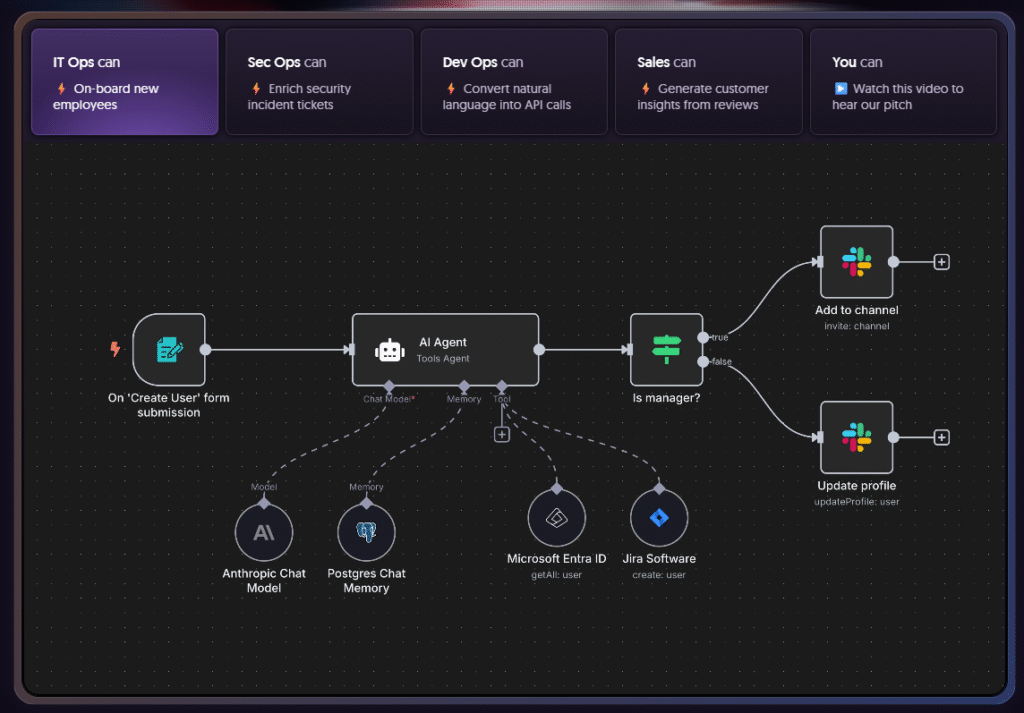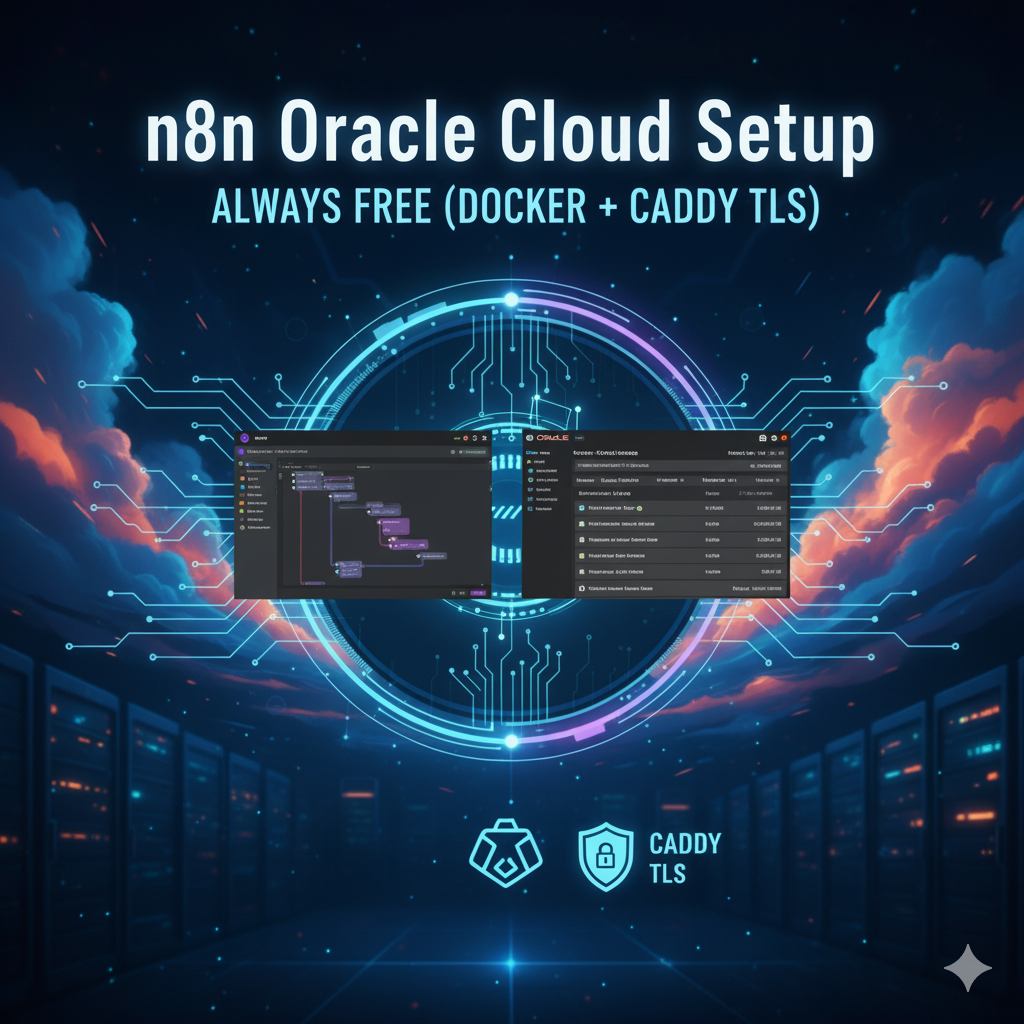Table of Contents
Why follow this tutorial
This walkthrough shows a complete, tested method to run n8n Oracle Cloud setup Always Free Ampere instance using Docker and Caddy as a reverse proxy with automatic Let’s Encrypt TLS. It covers DNS, Oracle VCN rules, Docker Compose configuration, IPv6 pitfalls and a proven fallback when Caddy can’t resolve container hostnames.
Prerequisites for n8n Oracle Cloud Setup
- Oracle Cloud account (n8n Oracle Cloud Setup) with Always Free resources (Ampere A1 recommended).
- A domain you control (DNS editor access) — e.g.
example.com. - Basic SSH knowledge and a terminal client (Termius, PuTTY, or native SSH).
- You will only need to edit email, domain, username, password in the example files.

Quick overview for n8n Oracle Cloud Setup
- Create Ampere A1 instance and assign a Public IPv4 (reserved recommended).
- Configure VCN/Subnet security lists (allow 22, 80, 443).
- SSH into the instance and install Docker / Docker Compose.
- Create
~/n8nfolder and adddocker-compose.yml+Caddyfile. - Launch containers, wait for certificates, test.
- Troubleshoot IPv6 / SSL issues and clear browser cache if needed.
- Backup workflows and maintain.
Step 1 — Create the Oracle instance + public IP
In Oracle Console → Compute → Instances → Create Instance.
- Choose Ampere A1 Flexible (Always Free eligible).
- Select Ubuntu (22.04 LTS ARM / aarch64) or the image you prefer.
- In Networking, ensure the VNIC is in a subnet with an Internet Gateway.
Make sure a Public IPv4 is assigned:
- In instance page → Attached VNICs → click the VNIC → under IPv4 Addresses, click Assign Public IP.
- Prefer a Reserved Public IP (won’t change on stop/start).
Note the public IP (example: 123.456.789.10) and use it in DNS.
Step 2 — DNS: Create an A record
At your DNS provider (Hostinger):
- Create an A record:
n8n→ points to your instance public IPv4 (123.456.789.10). - (Optional) If you have IPv6 and a working route assign AAAA to the server IPv6 — but only do this if your provider routes IPv6 correctly; otherwise leave AAAA blank (we address IPv6 below).
Wait a few minutes and verify:
Host: n8n Type: A Value: YOUR_PUBLIC_IPV4 TTL: default
Verify:
dig +short n8n.YOUR_DOMAIN @8.8.8.8
It should return your public IPv4.
Step 3 — VCN / Security Lists (Oracle Console)
Make sure your subnet has these ingress rules (source 0.0.0.0/0):
- TCP 22 — SSH
- TCP 80 — HTTP (required for Let’s Encrypt HTTP-01)
- TCP 443 — HTTPS
Also confirm the subnet route table has a route to the Internet Gateway.
Step 4 — SSH into the instance and prepare the server
SSH (Termius) to your public IP:
ssh ubuntu@123.456.789.10
SSH to your instance and run these commands to update, install Docker & Docker Compose and enable UFW:
sudo apt update && sudo apt upgrade -y sudo apt install -y docker.io docker-compose ufw curl jq sudo systemctl enable --now docker sudo usermod -aG docker $USER # Apply docker group to current shell (no logout required) newgrp docker # Firewall sudo ufw allow 22/tcp sudo ufw allow 80/tcp sudo ufw allow 443/tcp sudo ufw --force enable
Step 5 — Create project folder and files
From your home folder ~/ run:
mkdir -p ~/n8n && cd ~/n8n
Caddyfile (reverse proxy + TLS)
Create ~/n8n/Caddyfile — (replace YOUR_DOMAIN and YOUR_EMAIL):
YOUR_DOMAIN = n8n.YOUR_DOMAIN
YOUR_EMAIL = you@your-email.com
# Caddyfile content
n8n.YOUR_DOMAIN {
reverse_proxy n8n:5678
tls YOUR_EMAIL
encode gzip
# Optional: force IPv4 only if you encounter IPv6/SSL issues
# bind 0.0.0.0
}
Also Read : https://itgyan.in/how-to-claim-perplexity-pro-ai-for-free-airtel/
docker-compose.yml
Create ~/n8n/docker-compose.yml and replace placeholders: YOUR_DOMAIN, YOUR_EMAIL, YOUR_USERNAME, YOUR_PASSWORD.
version: "3.8"
services:
n8n:
image: n8nio/n8n:latest
container_name: n8n
restart: unless-stopped
environment:
- N8N_HOST=n8n.YOUR_DOMAIN
- N8N_PORT=5678
- WEBHOOK_URL=https://n8n.YOUR_DOMAIN/
- VUE_APP_URL_BASE_API=https://n8n.YOUR_DOMAIN/
- N8N_BASIC_AUTH_ACTIVE=true
- N8N_BASIC_AUTH_USER=YOUR_USERNAME
- N8N_BASIC_AUTH_PASSWORD=YOUR_PASSWORD
- GENERIC_TIMEZONE=Asia/Kolkata
- NODE_ENV=production
volumes:
- n8n_data:/home/node/.n8n
expose:
- "5678"
caddy:
image: caddy:2
container_name: caddy
restart: unless-stopped
ports:
- "80:80"
- "443:443"
volumes:
- ./Caddyfile:/etc/caddy/Caddyfile
- caddy_data:/data
- caddy_config:/config
depends_on:
- n8n
volumes:
n8n_data:
caddy_data:
caddy_config:
Step 6 — Launch the stack
From ~/n8n: n8n Oracle Cloud Setup
docker-compose up -d #Check Caddy logs to see certificate issuance docker-compose logs -f caddy
Watch the Caddy logs until you see “certificate obtained successfully” for your domain.
Step 7 — If Caddy cannot resolve n8n (fallback)
In some rare cases Caddy inside the container cannot resolve the service name. If your browser shows ERR_SSL_PROTOCOL_ERROR or blank pages, do this:
Get the n8n (n8n Oracle Cloud Setup) container IP:
docker inspect -f '{{range .NetworkSettings.Networks}}{{.IPAddress}}{{end}}' n8n
# Example output: 172.18.0.2
Update Caddyfile to use the container IP:
n8n.YOUR_DOMAIN {
reverse_proxy 172.18.0.2:5678
tls YOUR_EMAIL
encode gzip
bind 0.0.0.0 # optional: force IPv4
}
Restart:
docker-compose down docker-compose up -d
This was the exact fallback used to solve a DNS-in-container issue during testing.
Troubleshooting (most common issues)
SSL / ERR_SSL_PROTOCOL_ERROR
- Browser may prefer IPv6. Test IPv6 from the server:
curl -6 -vk https://n8n.YOUR_DOMAINIf IPv6 fails with Network is unreachable, force IPv4 in Caddy withbind 0.0.0.0. - Test IPv4:
curl -4 -vk https://n8n.YOUR_DOMAIN
DNS
- Make sure
dig A n8n.YOUR_DOMAIN +shortreturns your public IPv4. - If DNS changed, wait for propagation (minutes to a few hours).
Ports & firewall
- UFW on VM:
sudo ufw status - Oracle VCN Security List (n8n Oracle Cloud Setup) needs ports 80 & 443 inbound from
0.0.0.0/0.
Browser cache (client-side SSL errors)
- Chrome:
chrome://net-internals/#dns→ Clear host cache;chrome://net-internals/#sockets→ Flush socket pools. - OS-level DNS flush: Windows
ipconfig /flushdns, macOSsudo dscacheutil -flushcache && sudo killall -HUP mDNSResponder.
If Caddy refuses to issue certificates
- Check
docker-compose logs -f caddyforhttp-01ortlserrors. Often the cause is blocked port 80 or DNS not pointing correctly.
Backup & maintenance
Export workflows via the n8n UI (n8n Oracle Cloud Setup), or backup the Docker volume:
docker run --rm -v n8n_data:/data -v $(pwd):/backup alpine \ sh -c "cd /data && tar czf /backup/n8n_data_$(date +%F).tgz ."
For PostgreSQL setups, use pg_dump.
Update containers:
docker-compose pull docker-compose up -d
Uninstall / Clean everything
Run these commands to remove the deployment and data:
cd ~ cd n8n || true # Stop and remove containers docker-compose down # Remove volumes and network docker volume rm n8n_data caddy_data caddy_config || true docker network rm n8n_default || true # Prune unused docker objects docker system prune -f docker volume prune -f docker network prune -f # Remove files rm -rf ~/n8n
Frequently Asked Questions
Will this cost money on Oracle (n8n Oracle Cloud Setup)?
No — this uses Oracle Always Free eligible Ampere A1 resources. Make sure you stay within Always Free limits.
Why do I get SSL errors on my machine but not elsewhere?
Most likely IPv6 or cached failed TLS handshake. See browser DNS/socket flush steps or force IPv4 in Caddy.
Can I use Traefik instead of Caddy?
Yes — Traefik works too and offers a dashboard. Caddy is simpler for small setups.


